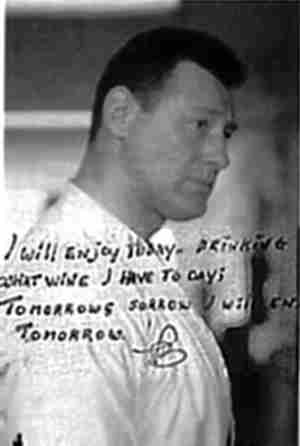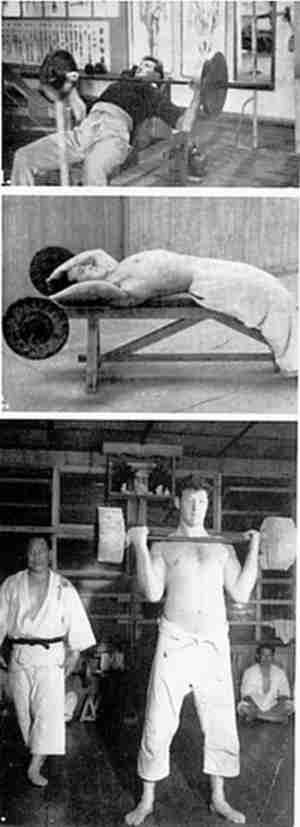
By Jon Bluming
Copyright © Jon Bluming 2000. All rights reserved.
I trained in budo in Japan from February 1959 to November 1961, and my standard schedule was this. (I know, it sounds terrible now, but I loved it then.)
On Monday, Wednesday, and Friday from 9:00 until 10:30 a.m. I did weight training at the Korakuen gym, which used to be the old Kodokan on Suidobashi and was by then the home of the Japan Karate Association. Donn Draeger was my weight coach, and Isao Inokuma was among my usual training partners.

Photos 1 and 2: Bluming training with weights at the Korakuen gym. Photo 3: In April 1959 Bluming tried to convince Mas Oyama (left) of the value of weight training, too, but the latter never went for it.
I’ll never forget my first power training. It was squats. We started out with sixty kilos, twenty times. By the time I was done, my legs were shaking. But Donn wasn’t done yet. Oh no. He simply added a couple more plates, and up we went to 120 kilos, which was a lot for me in those days. I barely got the weight up before I said, "We’ve got to come down. NOW!"
There were only three stairs down to the level one could buy fruit drinks and such. I put my foot on the first step and that was it. The other steps I never made; I just tumbled down. I thought, "Well, I still need my orange juice," so I crawled off to get it. I wanted to go home, but Donn said, "No resting. You go play." I said, "They’re going to kill me." "So what? Let them think they’ve got you."
So off I stumbled to the dojo, where even the brown belts knocked me around like some kid who had no idea of what to do. They had only to look at me and over I went.
After lunch, it was training in jojutsu, or short stick, from 2:00 until 3:00 p.m. This training took place at the Tomisaka police station or the Tokyo kidotai (police academy), and the instructor was Takaji Shimizu.
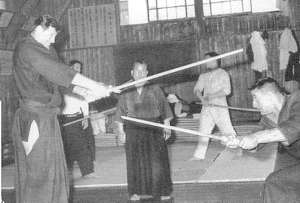
Left to right: Bluming, Shimizu, and Draeger, at the Tomisaka police station in August 1959.
Then it was back to the Kodokan for a nap, and then upstairs to the main dojo to fight as many as possible from 4:30 until 6:00 p.m. After a quick bite to eat, then it was over to the Oyama dojo to train in Kyokushin Kai karate from 7:30 until 9:00 p.m.
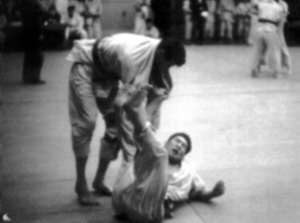
Bluming during his first 3-dan contest at the Kodokan, March 1959. The technique was okuri ashi barai.
On Tuesday and Thursday morning from 9:00 until 10:30 a.m. I went to the police dojo, the Keisho, where the judoka were rough and usually heavier than at the Kodokan. Once a year there was a tournament, the police against the students. It was a lovely spectacle to watch and many times the police won.
After lunch it was over to the Tomisaka police dojo for iaido and kendo training. This training lasted from 1:00 until 2:00 p.m., and the instructor was Ichitaro Kuroda Sensei.
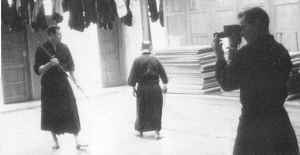
Jo instruction at the Tomisaka police dojo in the autumn of 1959. Left to right, Bluming, Kuroda, and, with camera, Donn Draeger
Then again back to the Kodokan for a nap, an hour and a half of judo on the main floor, dinner, and finally off to the Oyama dojo for some karate.
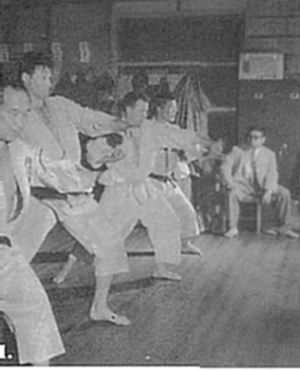
Left to right: Mas Oyama, Bluming, and Bill Backhus, April 1959. The occasion was a testing in front of the Japanese press.
Saturday and Sunday morning it was over to the Kyokushin Kai dojo for two hours and then in the afternoon to the Kodokan again. In between, and afterwards, it was back to the grind of selling encyclopedias at the US bases around Tokyo with Bill Backhus.
The really amazing thing was that Bill and I still had time for girls. Japanese girls are the nicest in the world as far as I'm concerned.
The iaido teacher, Ichitaro Kuroda Sensei, taught me much about the meaning of budo. He was one of those very patient teachers, very serious and devoted to his art and his budo but always with a smile and a kind word. Not once did I see him show annoyance or anything but love and respect towards his students no matter how clumsy they were, and he offered good advice which sadly I did not always follow.
I started training with him at the same time as Donn Draeger, and felt that I was getting somewhere when I could put the sword away without losing some of my fingers, or even (most of the time) getting a little cut on my hand. Besides sword, we also practiced stick (jo) and kusari gama, or ball and sickle on a chain, with Kuroda. Bill Fuller started training there a few months later; Jim Bregman also came by once in awhile. Quintin Chambers and those other guys all started their training years later.
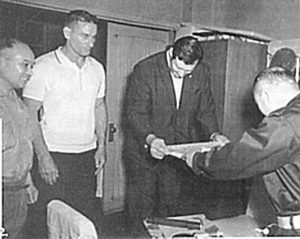
In June 1966, Bill Backhus and Jon Bluming were awarded commendations by the Tokyo police for their part in apprehending some car thieves. Here Bluming receives his award from the high commissioner of the Tokyo police. To his left are Ichitaro Kuroda and Donn Draeger.
I only missed class once. Sensei asked why the next time he saw me. "Simple," I said, "I did not have the money, as little as it seems, to pay you." He smiled and said that money was not important. Spirit was what counted, he said, not money, and I could come anyway. Even if I did not have the money he would teach me anyway.
That was Kuroda all the way , no wonder he was really admired, loved and respected by all of his students.
And that is also true budo.
Unfortunately it also got him screwed in the end for later all kinds of Europeans and Americans took advantage of his principles and honor to get top-quality training for free.
***
During the summer of 1961, knowing that I was soon to be leaving Japan, Mas Oyama doubled the time he spent with me training on Kyokushin Kai kata, and soon I had no time for anything but examinations and preparing for examinations. Yet despite all this extra training I still wore only a white belt in Oyama’s dojo. This was my private joke. Beginners always thought I was one of them, but after somebody told them who I was then they would call me Sempai, or senior. Meanwhile visiting black belts always loved lording it over the beginners, especially the foreigners. And of course I thought it pretty funny, too, them getting publicly thrashed by a gaijin white belt. Plus it was less embarrassing. For example, I saw the test Bobby Lowe did while wearing his black belt and it stank like a sewer. During kumite with Kenji Kurosaki he was all the time on the ground. Every time Kurosaki advanced he would drop on the ground with his leg up like the cowardly dog he is. Finally Kurosaki kicked him hard in his ass and told him that karate was done standing up.
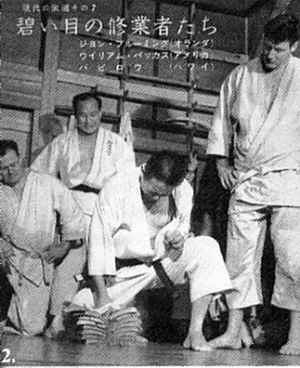
Hawaii's Bobby Lowe tested at the Honbu Dojo in 1959. Although he could break bricks, Bluming says he was hopeless as a fighter. From left to right, Bill Backhus, Mas Oyama, Bobby Lowe, and Jon Bluming. Note Bluming's white belt; he wore one at the Kodokan, too, until the management told him he couldn't do that because it was hard on morale for beginners to see Japanese team captains thrown by large foreign white belts.
Be that as it may, my first major grading was in jodo and iaido rather than karate. Toward the end of August 1961 Donn and I were invited to give a demonstration during the All-Japan Police kendo championships held at the Hibiya amphitheater. The Japanese TV was there and the show was broadcast live. It was a great success, too. But what we did not know at the time was that it was also our examination, and after the demonstration we got a big hand from the police dojo instructors and received our 3-dan ranking and the lowest teachers’ certificates.
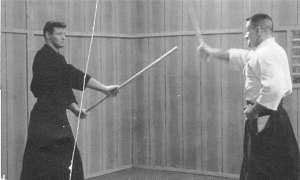
A photo taken during the demonstration for Japanese TV in August 1961. Bluming is on the left and Draeger is on the right.
Afterward Donn and I spent a couple days at Ninomiya, which is on the water about forty kilometers outside of Tokyo. We stayed at a lovely old-fashioned inn with a beautiful garden and beach access. We swam and talked and trained with our wooden swords. The waves were sometimes as much as eight meters high, and diving under them was like being picked up by a giant hand, scraped over the shells on the bottom, turned upside down, and then thrown on the beach like a rag doll. After awhile of fighting that hand, I was so tired that I offered my breakfast to the crabs on the beach. That was how I learned you cannot fight a big wave, and it was a day to remember for the rest of my life.
